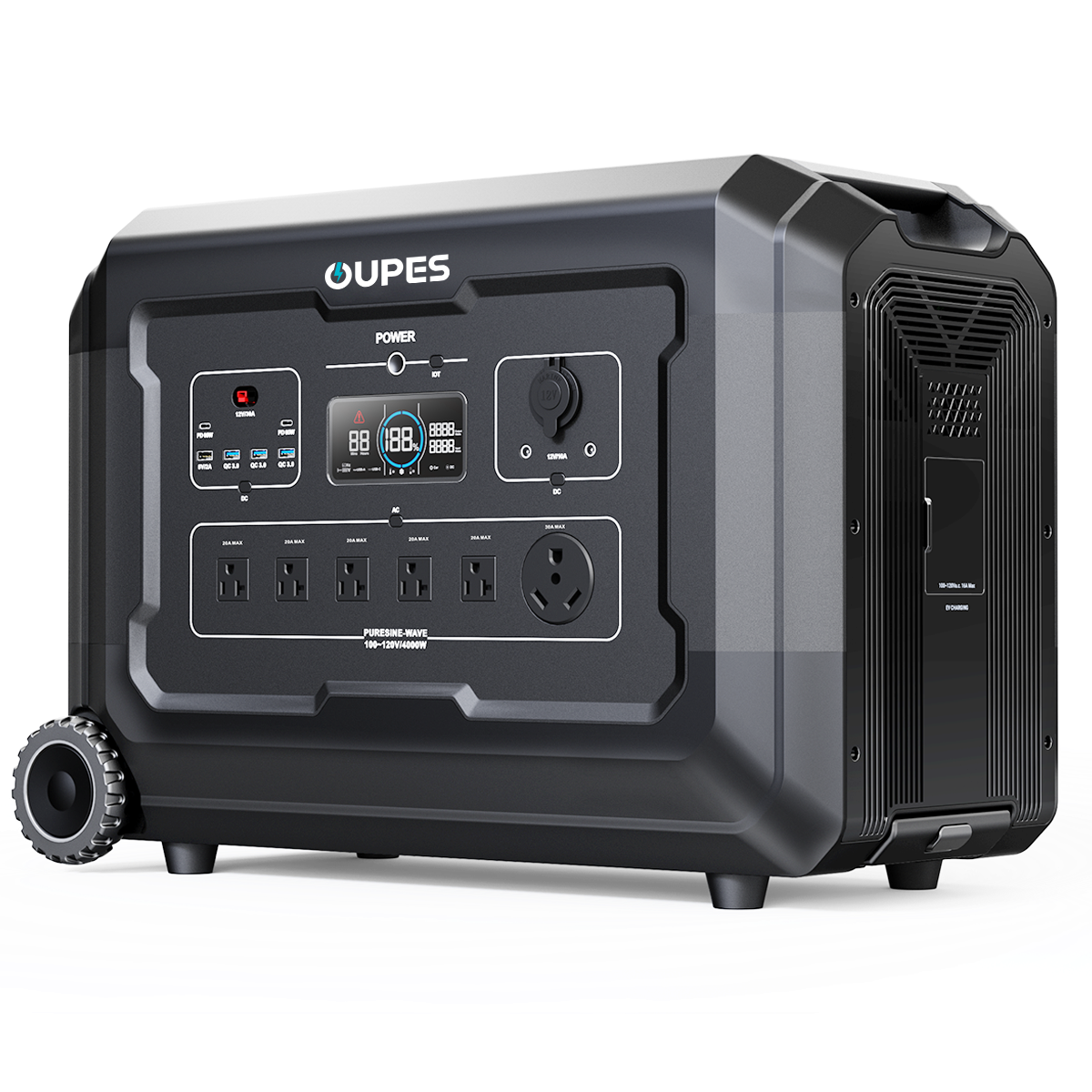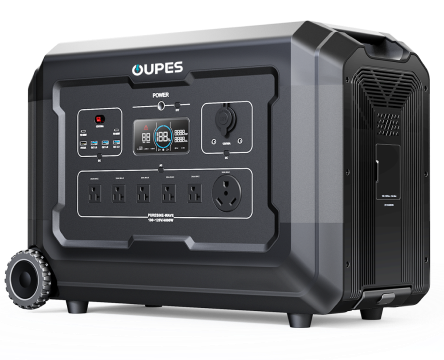
When temperatures drop and power outages strike, staying warm becomes more than a comfort—it becomes a necessity. For those living in areas prone to harsh winters or unreliable electrical grids, space heaters are often the first line of defense against the cold. But when the grid goes down, can a solar generator step up to the challenge? This article dives deep into the capabilities of portable solar generators, exploring whether they can truly power a space heater, how to choose the right one, and how OUPES solar generators fit into your emergency or off-grid lifestyle.
Read on to learn about wattage requirements, battery capacity, and best-use practices—because when the storm hits, preparation is your best ally.
Understanding the Power Needs of Space Heaters
Space heaters come in many sizes and types, but they all share one common trait—they demand a lot of power. Most residential electric space heaters require anywhere from 750 watts to 1,500 watts of continuous power. This level of energy draw is significant, especially for a portable power source like a solar generator.
It’s essential to understand the terms involved: “watts” refers to the rate of energy consumption, while “watt-hours” measures how much energy is used over time. A 1,500-watt heater running for one hour consumes 1,500 watt-hours (or 1.5 kilowatt-hours). That means, if your solar generator has a capacity of 1,000Wh, it could theoretically power a space heater for less than an hour before running out of juice—assuming there’s no power loss.
It’s also important to check the "surge power" requirements. Some heaters may require a brief power spike to start up. If your solar generator can’t meet that surge requirement, it may shut down or fail to start the heater entirely. This is where high-quality inverters like those found in OUPES solar generators make a difference. They can handle both continuous and surge loads effectively, ensuring stable and safe operation of high-draw devices.
In summary, before using a solar generator with a space heater, you must know your heater’s wattage, understand how long you plan to use it, and ensure the generator’s inverter can handle the load. Without this knowledge, you risk overloading your generator or depleting its battery much faster than anticipated.
Choosing the Right Solar Generator for Heating Applications
Not all solar generators are created equal—especially when it comes to running high-wattage appliances like space heaters. If you're serious about using solar power for heating, you need a unit with a high-capacity battery, powerful inverter, and fast charging capabilities.
The first thing to look at is battery capacity, measured in watt-hours (Wh). For instance, if you plan to run a 1,500W heater for 2 hours, you need at least a 3,000Wh generator—not accounting for efficiency losses, which are typically around 10-20%. That’s why many people looking to power space heaters off-grid consider models like the OUPES Mega series, which offer expandable battery options.
Next is inverter power. Your generator’s inverter must be rated higher than the space heater’s wattage. A heater requiring 1,500W needs an inverter that can consistently output at least 1,500W, with some overhead for safety. Some space heaters can spike up to 1,700W at startup, so surge capacity is equally important.
Lastly, consider solar input and recharge rate. If your solar generator only supports low-wattage panels, it may take too long to recharge, limiting daily runtime for your heater. OUPES units, for example, are compatible with high-efficiency solar panels that speed up recharge cycles, making daily off-grid heating more practical.
To summarize, choose a solar generator with at least 2,000Wh capacity, a 1,500W or higher inverter, and scalable solar input. The investment pays off when temperatures plummet and you need reliable, renewable heat.
Managing Expectations: Runtime and Efficiency in Real Use
Even with a robust solar generator, powering a space heater comes with trade-offs. These devices consume power rapidly, and runtime is often limited to just a few hours—even with large-capacity models. That means using a space heater off-grid requires strategic thinking.
Start by calculating realistic runtimes. For example, if your solar generator has a 2,000Wh battery and you’re using a 1,500W heater, the theoretical maximum runtime is about 1.3 hours. But due to inverter losses and voltage drops, real-world performance might only give you one hour of heat. That’s enough to warm a small room or take the chill out of the air, but it won’t last overnight.
Instead of relying solely on a space heater, combine heating methods. Insulate your space, use heated blankets, and wear thermal layers to reduce your heating load. Use the space heater intermittently—perhaps 15-20 minutes every hour—to maintain comfort while preserving battery life.
Also, consider the environment in which you’re using the heater. Heating a poorly insulated garage is far less efficient than warming a small, insulated tent or camper. The smaller and more thermally sealed your space, the longer your battery will last.
For more sustainable use, recharge your solar generator during the day and use the heater only when absolutely necessary. OUPES solar generators allow for fast solar recharging, so you can potentially restore a portion of your battery during daylight hours and extend your usable heat window.
In essence, managing your expectations is key. You can use a solar generator to power a space heater, but doing so smartly—by limiting runtime, improving insulation, and supplementing with other methods—makes all the difference.
Why OUPES Solar Generators Are Ideal for Emergency Heating
When evaluating solar generators for emergency or off-grid heating, OUPES stands out for its reliability, performance, and flexibility. Built with lithium iron phosphate (LiFePO4) batteries, OUPES units offer longer lifespans, enhanced safety, and better thermal stability—critical when dealing with winter conditions.
OUPES solar generators also feature powerful pure sine wave inverters, capable of running high-wattage devices like electric heaters, hair dryers, or electric kettles. Their surge capacity ensures your appliances start up without issue, even under load. That makes them dependable in time-sensitive situations, like warming a room during a blackout.
Moreover, the OUPES ecosystem includes expandability options. If your base model doesn’t provide enough power for prolonged heater use, you can add expansion batteries. This makes the system scalable depending on your needs—ideal for families, campers, or preppers looking to cover multiple rooms or longer outages.
In addition, OUPES generators integrate with efficient solar panels, offering quick recharging even in low-light winter conditions. That means you’re not just relying on stored power, but actively replenishing it each day.
Finally, the user interface and monitoring system make it easy to track input/output and battery status in real time, so you always know how much heating time you have left. This is invaluable when trying to ration power effectively over cold nights or during storms.
In short, if you’re looking for a dependable, solar-powered solution for space heating, OUPES is a name you can trust.
Smart Heating Alternatives to Conserve Power
While it’s technically possible to power a space heater with a solar generator, it’s not always the most energy-efficient choice. If your goal is to stay warm while maximizing your generator’s performance, consider using lower-power alternatives that stretch your battery life much further.
Heated blankets, for instance, typically consume just 50–100 watts, yet they provide direct body heat far more effectively than space heaters. Paired with a sleeping bag or heavy blanket, they can keep you comfortable for hours on end, using just a fraction of the energy a heater would.
Another efficient option is a heated mattress pad. Like heated blankets, they focus warmth where it’s needed most and can be powered by compact solar generators without draining your battery quickly. Some people also use infrared heating pads or small ceramic personal heaters, which offer localized warmth without heating an entire room.
Passive heating strategies can also help. Thermal curtains, window insulators, and foam weather stripping reduce heat loss and retain warmth generated from any source. By combining passive and active heating methods, you can extend the utility of your solar generator and maintain comfort through long outages.
In essence, using a solar generator for heating doesn’t have to mean blasting a 1,500W heater nonstop. With a smart approach and the right tools, you can stay warm, conserve power, and make your generator last as long as needed—without sacrificing safety or comfort.
OUPES power stations support this kind of modular, efficient use. Whether you’re charging a heated blanket, LED lighting, or a low-draw air purifier, these devices perform well under load and provide peace of mind during emergencies.
Conclusion
So, can a solar generator power a space heater? Absolutely—but not without limitations. While portable solar generators like those from OUPES are capable of running high-wattage appliances, space heaters draw significant amounts of power and can quickly deplete your battery if used continuously.
To get the most out of your solar generator, choose a model with high battery capacity, a robust inverter, and rapid recharge capabilities. Supplement your heating strategy with insulation, smart energy use, and lower-draw alternatives to stay warm without draining your resources. With the right tools and planning, solar-powered heating can be a practical solution—even when the grid goes down.




























